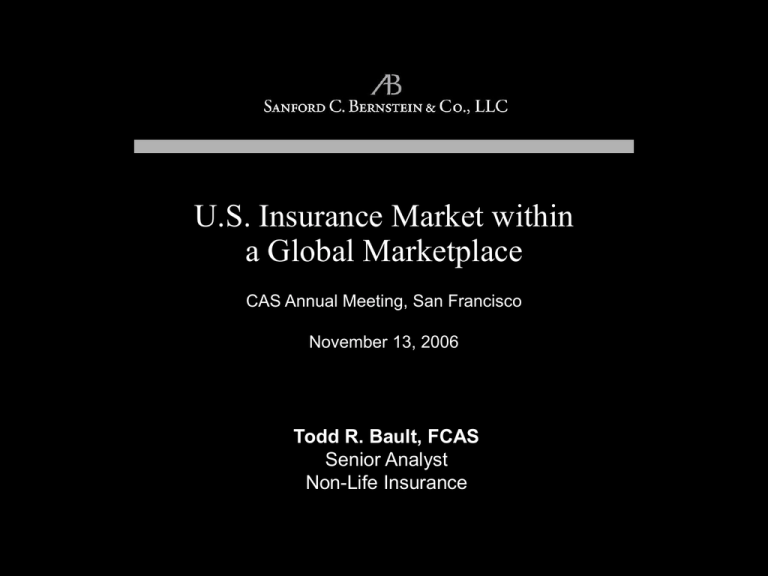U.S. Insurance Market within a Global Marketplace Todd R. Bault, FCAS Senior Analyst
advertisement

U.S. Insurance Market within a Global Marketplace CAS Annual Meeting, San Francisco November 13, 2006 Todd R. Bault, FCAS Senior Analyst Non-Life Insurance Agenda Market update: When will the skeptics be right? Pricing down, but what else is new? Look at reserves, not pricing Does the cycle influence loss trend? Thoughts on the global insurance marketplace Catastrophe pricing and capital usage: Confusion reigns Securitization and capital markets: Baby steps Capital flight to tax-advantaged locales: Lloyd’s goes to Hamilton M&A: Europe Yea, US Nay Q&A Open Slide Master > Insert Tracking Code Sanford C. Bernstein, LLC Warning I will not discuss any publicly-traded insurance companies I’ll blab all day about non-public companies and the industry Please frame questions generically where possible! Open Slide Master > Insert Tracking Code Sanford C. Bernstein, LLC Market update: When will the skeptics be right? Currently in the midst of a property cycle Driven by increased US Gulf wind frequency in 2004-05 ALL peak catastrophe exposures have gone up in price (e.g. Northeast wind, earthquake) Abnormally low cats this year likely mark the peak of the cycle All other major lines profitable but softening This has been happening since 2004—not a new issue Loss trends cyclically low and helping to sustain profits Loss reserve adequacy continues to improve Redundancies on 2003-06 offsetting small deficiencies in late 90s Corresponds to early 90s behavior—further improvement likely but smaller in magnitude Open Slide Master > Insert Tracking Code Sanford C. Bernstein, LLC Market update: When will the skeptics be right? May be nearing the point where the market becomes generally soft First need most pricing declining (already there) Next need loss trends to increase (starting to occur) Finally need reserve releases (2-3 years from now) This set of conditions corresponds to 1995-97, prior to late 90s soft market Current market discipline not unprecedented (e.g. 1989-94) Until trends and reserves deteriorate, results could remain strong We call this the “post cycle”: the period after a hard market where growth is low but profits stay strong Coincident with low pricing, low loss trends, and strengthening loss reserves Stock performance tends to be good in the post cycle: stocks are cheap but grow their book value (but not premium or earnings) Open Slide Master > Insert Tracking Code Sanford C. Bernstein, LLC Pricing down, but what else is new? Estimated price changes for select commercial lines, 1999-2006 50% 40% 30% 20% 10% 0% -10% Property Casualty 2006-3 2006-2 2006-1 2005-4 2005-3 2005-2 2005-1 2004-4 2004-3 2004-2 2004-1 2003-4 2003-3 2003-2 2003-1 2002-4 2002-3 2002-2 2002-1 2001-4 2001-3 2001-2 2001-1 2000-4 2000-3 2000-2 2000-1 1999-4 -20% Work Comp Sources: CIAB, Bernstein analysis Pricing is down in most lines but Property, and even this may be fading But this has generally been true since 2004 (circled area) Ex-catastrophe industry profits are at record levels for 2004-06 So why the apparent disconnect? Open Slide Master > Insert Tracking Code Sanford C. Bernstein, LLC Loss trends down even more than pricing Estimated price changes and loss trends, 2000-2006 20001 20002 20003 20004 20011 20012 20013 20014 20021 20022 20023 20024 20031 20032 20033 20034 20041 20042 20043 20044 20051 20052 20053 20054 20061 20062 Estimated price change Auto Liability Property 10% 6% 5% 14% 7% 9% 17% 7% 13% 19% 8% 17% 21% 11% 19% 23% 13% 23% 23% 15% 25% 23% 17% 29% 23% 18% 33% 22% 21% 35% 22% 23% 35% 21% 22% 31% 19% 20% 25% 17% 17% 18% 14% 14% 12% 11% 11% 7% 8% 8% 2% 5% 5% -2% 3% 2% -5% 1% 0% -7% -1% -3% -9% -3% -5% -10% -5% -6% -11% -5% -7% -10% -5% -7% -7% -5% -6% -2% Sources: CIAB, ISO, Bernstein analysis Open Slide Master > Insert Tracking Code Estimated loss trend Auto Liability Property 2% 2% 8% 5% 1% 17% 8% 4% 10% 8% 6% -5% -1% 5% -4% -9% 4% -14% -6% 1% -11% -2% -2% -14% -2% -6% -17% -4% -9% -9% -3% -11% -17% -2% -14% -17% -4% -12% -12% 0% -10% -21% 2% -13% -12% 5% -15% -7% 9% -16% -7% 10% -16% 7% 11% -5% 2% 10% 8% 2% 9% 9% -1% 10% 10% -7% 10% -1% -3% 11% -3% -3% 9% -3% -3% 7% -3% -1% The disconnect is loss trends, which have been negative since the 2001-03 cycle Most of this is driven through frequency This appears to have happened in the past (e.g. early 90s) Loss trends are much less carefully monitored outside the industry, thus the disconnect Sanford C. Bernstein, LLC Look at reserves, not pricing 20% 100% 10% 80% Reserve adequacy 0% 60% -10% 40% -20% 20% -30% 0% -40% -20% -50% Adequacy/surplus excl. old years 2007E 2006E 2005E 2004E 2003 2002 2001 2000 1999 1998 1997 1996 1995 1994 1993 1992 1991 1990 1989 1988 1987 1986 1985 1984 -60% 1983 -70% 1982 -40% 1981 -60% Cumulative relative stock performance Industry reserve adequacy vs. insurance stock outperformance, 1981-2007E Relative performance Sources: Best’s, ISO, Highline Data via NAIC filings, Bernstein analysis Changes in reserve adequacy a much better leading indicator for cycle Reserve strengthening coincident with market improvements Reserve releases leads soft market by 2-3 years Verified in academic work examining balance sheet accruals and stock performance Favorable accruals (e.g. reserve releases) signal underperformance Open Slide Master > Insert Tracking Code Sanford C. Bernstein, LLC Does the cycle influence loss trend? Relationship of price increases to future frequency changes, property (left) and liability (right) 40% 25% 35% 20% 25% Price C h an g e P ric e C h a n g e 30% 20% 15% 10% 5% y = - 1 .5 1 x - 0 .0 3 R 2 = 0 .8 9 15% 10% 5% 0% -5% -10% -30% -20% -10% 0% Fr e q u e n c y C h a n g e ( 1 Y r L a g ) 10% 0% -25% y = - 1.04 x + 0.00 R 2 = 0.89 -20% -15% -10% -5% 0% Fr e q u e n cy C h an g e (1 Yr L ag ) Sources: CIAB, ISO, Bernstein analysis Past losses influence future pricing, but does past pricing influence future losses? It seems to, through claims frequency: frequency declines after price increases (data above 1999-2005) Theory: Exposure cuts after a hard market (“terms & conditions”) reduces claim counts but is not captured fully in exposure bases Phenomenon exists in every line we can measure (from personal auto to D&O), and appears global (comment from an Australian CEO) This result needs more testing, with better data than I have! Open Slide Master > Insert Tracking Code Sanford C. Bernstein, LLC Global issues Catastrophe pricing and capital usage When US property reinsurance pricing hardened, many predicted Europe to follow Reasons: 1) inadequate price 2) capital rationing Argument for 2): reinsurers will deploy capital towards betterpriced risks and pull it away from worse-price risks Capital rationing has not come to pass this cycle Theory: insurance market doesn’t ration capital, it prices risk Regulators ration capital, but market is used to this Capital “allocations” are contingent and notional No hard money is flowing anywhere, unlike the stock market Market needs either an event or balance sheet shock to begin rationing capital Open Slide Master > Insert Tracking Code Sanford C. Bernstein, LLC Global issues Capital inflows vs. industry premium growth, 1985-2005 Hard Post-cycle Hard Post Soft Hard Post 3.5% 25% 3.0% 20% Inflows/surplus 2.0% 1.5% 15% Northridge earthquake Hurricane Andrew 1.0% 9/11 attacks 0.5% 10% 0.0% -0.5% Premium growth 2.5% 5% -1.0% Smoothed capital inflows 2004 2003 2003 2002 2001 2000 2000 1999 1998 1997 1997 1996 1995 1994 1994 1993 1992 1991 1991 1990 1989 1988 1988 1987 1986 1985 0% 1985 -1.5% Premium growth Sources: ISO, Bernstein analysis In fact, capital inflows signal price increases in insurance Chart is total US industry, where premium is a reasonable pricing proxy This surprises many investors, who assume capital flowing in dampens prices But insurers only ask for capital in the face of potential pricing strength Open Slide Master > Insert Tracking Code Sanford C. Bernstein, LLC Global issues Securitization and capital markets: Baby steps Securitization in insurance still disappointing despite hype For example, cat bond market on its way to its biggest year ever, yet is still less than 2% of world reinsurance capacity Compare to credit derivatives (which started about the same time as cat bonds in the mid-90s), which are now many times the size of the global reinsurance market (by limit) Why the failure? Basis risk is shunned by capital markets No way to hedge except with true reinsurance Parametric bonds simply push basis risk onto end user Contingent capital may be the better way forward Design products to provide lump of dollars when most needed ILWs do this, as do sidecars (private reinsurers)—these and other product may replace the traditional retro market Open Slide Master > Insert Tracking Code Sanford C. Bernstein, LLC Global issues Capital flight to tax-advantaged locales: Lloyd’s goes to Hamilton Despite vast improvement in Lloyd’s underwriting, syndicates continue to move to tax-advantaged locales Function of the global marketplace more than Lloyd’s Prediction: Bermuda will lose future influence simply because other regions will offer comparable advantages For example, Lloyd’s lobbying FSA for tax exemption M&A: Europe Yea, US Nay Discussions of insurance M&A all over Europe, but with no followthrough in the US Seems driven by standard arguments of scale economies, etc. Ignores US state regulation, which conspires to keep industry fragmented Need Federal regulation or a much softer market for US M&A Open Slide Master > Insert Tracking Code Sanford C. Bernstein, LLC


